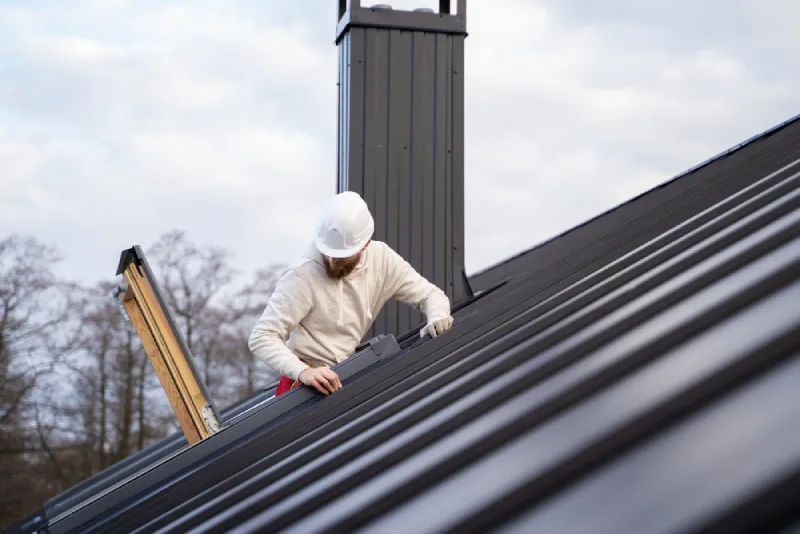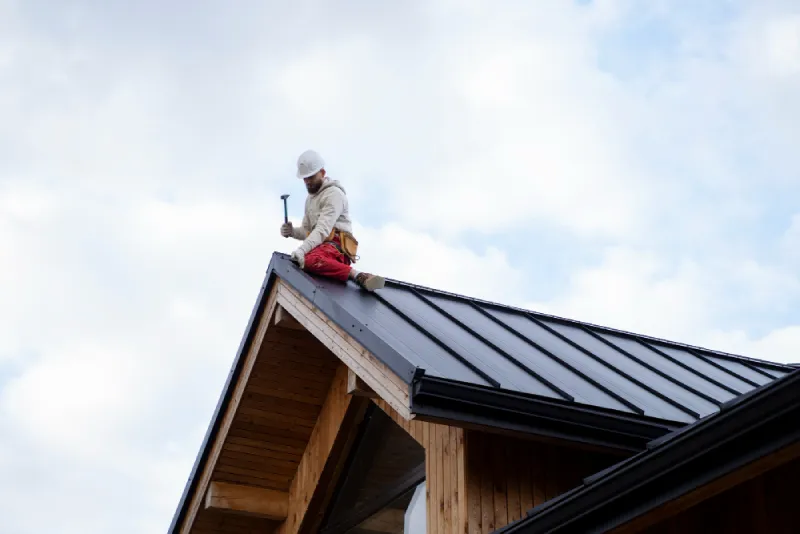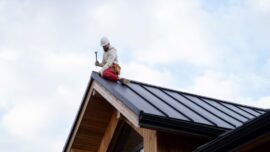
Guide to Tile Roof Repair: A Homeowner’s Step-by-Step Manual
Your roof is more than just a shelter; it’s your first line of defense against Florida’s unpredictable weather. In this blog, we’ll share valuable insights and tips on tile roof repair, demystifying the process to ensure your roof remains sturdy and reliable. From enhancing curb appeal to safeguarding your home, we’ve got you covered. We’ll help you make the most of your investment and protect your cherished space.
Tile Roof Repair Basics
Tile roof repair is not just a routine maintenance task; it’s a crucial investment in your home’s longevity and peace of mind. Your roof shields you from Florida’s harsh elements, and if left unattended, even minor issues can escalate, causing costly damage to your property. Repairing your tile roof is a cost-effective solution that tackles specific issues, like cracked tiles or minor leaks, without the expense of a full replacement.
Minor Roof Leaks
Repair small leaks or isolated damage to tiles promptly to prevent water infiltration and further damage. If a large portion of the roof is damaged or aging, replacement may be more cost-effective in the long term.
Cracked or Broken Tiles
Individual cracked or broken tiles can often be replaced, preserving the overall roof structure.
Localized Damage
If the damage is limited to a specific area, tile roof repair is a cost-effective option, saving you from a full roof replacement.
Regular Maintenance
Routine maintenance and inspections can catch small issues early, allowing for timely tile roof repairs and preventing the need for a costly replacement.
Old Age
Tile roofs have a finite lifespan, typically around 50 years. If your roof is nearing this age, consider a replacement for improved safety and performance.
Understanding Common Issues with Tile Roofs
Tile roofs exude timeless beauty, but they’re not immune to wear and tear. Knowing the common issues can help you maintain your roof’s longevity. Different tile types have unique vulnerabilities; clay tiles may crack, while concrete tiles can erode. Over time, tiles can become loose, and weather-related damage is a constant threat.
Heavy Rain
Intense rain can cause leaks and water damage, particularly if tiles are damaged or improperly installed.
High Winds
Strong winds can dislodge tiles, leaving your roof vulnerable to further damage.
Extreme Heat
Prolonged exposure to the scorching sun can cause tiles to warp or fade, diminishing their functionality.
Freezing Temperatures
In colder climates, freeze-thaw cycles can expand and contract tiles, leading to cracks and deterioration.
Regular inspections and prompt tile roof repairs are essential to combat these issues, ensuring your tile roof and Florida’s weather challenges stand the test of time.
Materials Used in Tile Roof Repairs
When tackling such tile roof repairs, having the right materials on hand is vital. Here are four essential tools and supplies you’ll need:
Replacement Tiles
Ensure you have matching tiles in terms of style, color, and material to replace damaged ones seamlessly.
Roofing Adhesive or Mortar
This material is crucial for securely fastening tiles in place and filling gaps, preventing leaks.
Underlayment
A weatherproof underlayment adds an extra layer of protection, keeping your roof watertight.
Roofing Nails or Screws
These are necessary for securely affixing tiles to the roof structure.
Identifying Cracks and Holes
Identifying tile roof cracks and holes is crucial for maintaining your roof’s integrity and preventing costly water damage. A regular visual inspection can help you catch these issues early, allowing for timely tile roof repairs and avoiding more extensive damage to your home. Start with a visual inspection, keeping an eye out for these signs:
- Visible Cracks — Cracked tiles are a telltale sign of roof vulnerabilities.
- Loose or Missing Tiles — Dislodged or absent tiles can expose the underlayment to water.
- Water Stains on Ceilings — Interior water stains often indicate a roof leak.
- Mold or Mildew Growth — Dampness from a leak can foster mold and mildew growth, a clear sign of water intrusion.
Repairing Cracks and Holes
Repairing tile roof cracks and holes is essential to safeguard your home from water damage. Regular inspections and timely tile roof repairs are key to maintaining the integrity of your tile roof, preventing water leaks, and preserving the beauty of your home.
Scrubbing the Affected Area
Thoroughly clean the damaged area to remove dirt, debris, and any loose tile fragments.
Filling Techniques and Materials
- Tile Adhesive or Roofing Cement — Apply a generous amount of tile adhesive or roofing cement to the crack or hole, ensuring it’s evenly distributed.
- Mesh or Fabric — Place a mesh or fabric patch over the damaged area for larger holes, providing extra support.
- Smooth the Surface — Use a putty knife to smooth the repair material and blend it with the surrounding tiles.
- Allow to Cure — Allow the repair to cure as per the manufacturer’s instructions.
Replacing Broken Tiles
Replacing broken tiles is a vital aspect of tile roof maintenance that ensures the longevity of your roof. Following these steps, you can effectively replace broken tiles and keep your tile roof in top shape. Here’s a concise guide on the process:
Safely Removing Damaged Tiles
Start by carefully prying up the broken tile using a putty knife or similar tool, ensuring no damage to neighboring tiles. Be cautious to prevent any debris from falling into the roof structure, which could lead to further issues.
Installing New Replacement Tiles Correctly
Place the new tile in the gap, securing it with adhesive or mortar as needed. Ensure the new tile sits flush with the surrounding tiles for a seamless look. Proper installation is key to maintaining your roof’s watertight integrity and aesthetic appeal.
Seeking Professional Help for Tile Roof Repairs
The allure of DIY projects is understandable. However, there are times when the expertise of a professional is not just advantageous but necessary. Here are possible reasons why DIY repairs are not enough:
Complex Damage
Roof issues often involve underlying problems that require expert evaluation.
Safety Concerns
Working at heights can be perilous; professionals have the tools and experience to ensure safety.
Long-term Solutions
Roofing experts offer lasting tile roof repairs that DIY fixes may not guarantee.
Cost-Effective
In some cases, DIY attempts can exacerbate problems, leading to higher costs in the long run.
For your tile roof’s health and longevity, consider the benefits of professional help when needed. A roofing expert offers invaluable insights and warranty protection that DIY doesn’t have.
- Precise Diagnosis: Professionals identify hidden issues that DIYers may overlook.
- Quality Workmanship: Skilled roofers deliver durable, aesthetically pleasing results.
- Warranty Protection: Most experts provide warranties on their work, ensuring peace of mind.
- Time and Cost Savings: Hiring a professional often saves time and money compared to multiple DIY attempts.
Addressing Leaks Beneath Tiles
Addressing leaks beneath tiles is crucial to prevent water damage and maintain your home’s integrity.
Inspecting for Hidden Leaks Within Your Home
Check your home’s interior for water stains or damp spots on ceilings and walls. These can be indicative of roof leaks. Inspect your attic or crawl spaces, as leaks can go unnoticed for a long time, causing structural damage.
Fixing Leaks Caused by Issues with Protective Membranes
Leakage often results from protective underlayment or flashing issues. A professional assessment is essential to locate the problem. It may involve sealing breaches in the membrane or flashing or replacing damaged sections to ensure your tile roof remains leak-free.

Safety Precautions for Tile Roof Repairs
Safety should be a top priority when undertaking tile roof repairs. Here are two essential precautions to follow:
Personal Protective Equipment (PPE)
Always equip yourself with the necessary PPE. This includes a hard hat, slip-resistant footwear, gloves, and safety glasses to protect against potential falls, debris, and accidents. Roofing work can be hazardous, and PPE is your first line of defense.
Proper Ladder Usage and Safe Movement on the Roof
Ensure your ladder is sturdy and placed on a stable surface. Use ladder stabilizers to prevent slipping. When on the roof, stay cautious and avoid stepping on fragile tiles. Distribute your weight evenly, move slowly, and use roofing harnesses if necessary.
Tile Roof Repair FAQs
Can broken roof tiles be repaired?
Absolutely! Broken roof tiles can often be repaired rather than replaced. This involves applying adhesive or roofing cement to reattach the broken pieces or using a patching material to fill in the gaps.
How do you fix a leaky tile roof?
Fixing a leaky tile roof involves a thorough inspection to locate the source of the leak. Once identified, the damaged tiles or underlayment are replaced, and any cracks or holes are sealed with roofing cement.
How are roof tiles fixed?
Roof tiles are fixed by removing the damaged ones, applying adhesive or mortar to secure the new tiles in place, and ensuring a seamless, watertight connection with the surrounding tiles.
How do roof tiles get damaged?
Roof tiles can get damaged due to various factors, including harsh weather conditions, improper installation, falling debris, or simply aging over time. Regular inspections and maintenance can help identify and address these issues before they worsen.
How do you fix a broken roof tile without replacing it?
Remove debris and clean the damaged tile and surrounding area. Use roofing adhesive or tile roof repair compound to bond the broken pieces securely. Once dry, smooth the repair material to blend with the tile’s surface.
Conclusion
Regular roof maintenance is the cornerstone of ensuring the longevity of your tile roof. By scheduling routine inspections and addressing issues promptly, you can prevent costly damage and maintain your roof’s pristine appearance. Don’t wait for small problems to become major headaches. Contact us today to schedule a tile roof inspection, ensuring your investment stands strong against the elements for years.





